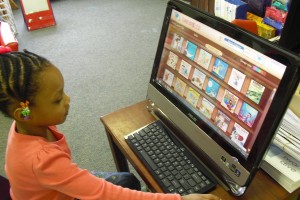
So is Quality Rating Tool 2 any better? We will now hone in on our data to see if we have achieved better reliability with Tool 2. The following 4 charts show the inter-rater reliability on three subscales of version 2 of the e-Book Quality Rating Tool. Ten independent raters evaluated 5 books by assigning each book a score between 1 (strongly disagree) and 5 (strongly agree) on ease of use, multimedia and interaction features. Ratings were considered reliable if they fell within +1 point of the rating assigned by the Expert Rater, the project technology expert.
Read the rest of this entry…
none
Drawing on this professional knowledge base, we developed a matrix to guide the design of a prototype tool for evaluating the e dimension of the early childhood e-book. This matrix provided a framework for organizing the tool (categories & elements) and specified criteria for judging the electronic environment. We used the Quality Rating Tool 1 with a set of internal raters, consisting of 4 teachers, and also external raters, who were members of our research team.

Read the rest of this entry…
none
From the Blueprint Key, we moved to the development of 2 unique analytic tools. Analytic Tool I was adapted from the coding categories of de Jong and Bus (2003) and focused primarily on multimedia/ interactivity design features. This tool uses the entire e-book as the unit of analysis. It is organized into four categories—Book Assistants; Multimedia Illustrations; Multimedia Print; Interactivity—that reflect the major early literacy learning domains of Book Handling, Comprehension, Word Recognition and Cognitive Processing. The four categories include 14 elements that describe ebook design (e.g., presence of static and/or animated illustrations).

Read the rest of this entry…
none

In Phase 1, our research goal was to design an effective and usable tool for early childhood teachers to us in order to rate the quality of the e-Book for use in early literacy instruction. Our interest in developing an e-Book rating tool began in 2008 with our first attempt, the Blueprint Key, and has evolved over time by blending several different analytic tools to create the most recent version, the Quality Rating Tool. Let’s take a closer look at the evolution of each component of the Quality Rating Tool.

Read the rest of this entry…
none

e-Books are becoming increasingly common in our society. Children and adults can read e-Books easily using devices such as the Kindle, Nook, iPods, iPads, iPhones, and computers. The speed at which e-Books are adapted into routine use could be accelerated even faster as communication technologies such as Wi-Fi and smartphones become more common in people’s daily lives.
So, then what does this mean in regards to e-Book reading from the perspective of e-Book pedagogy in early childhood classrooms? What do we know about the quality of current e-Books that many children are reading? During this presentation, we will briefly explain an e-Book instructional model in early literacy, and then we will focus on the issue of developing an e-Book quality-rating tool.
Read the rest of this entry…
none
This past week I had the privilege to present some of my e-Book research with my colleague, BK You from the Southwest Institute for Families, at the inaugural Early Education and Technology for Children Conference in Salt Lake City, Utah. This unique event was sponsored by the Waterford Institute and featured well-known speakers such as Dr. Grover J. “Russ” Whitehurst, Dr. Marilyn Jager Adams and Dr. John Dexter Fletcher, just to name a few.
Read the rest of this entry…
one
e-Books will likely be a part of future early childhood classrooms, and in light of the thin evidence base on their role in curriculum and instruction, we undertook a formative study to investigate what e-book pedagogy for early literacy might look like in the early childhood classroom [1]. We approached our research from a design perspective—much like an engineer—creating a prototype model for implementation in the classroom and testing it to begin a winnowing process that informs the educational design (e-books in preschool for purposes of early literacy instruction) and identifies design features that are feasible and preferable in an instructional model [2, 3].
At this early stage of prototype creation, we conceptualized an e-book instructional model that was purposefully under-specified to allow a wide-angle view of what it takes and what happens when e-book technology is inserted into the preschool classroom. The model consists of four components grounded in e-book studies [4] and the knowledge base on early literacy instruction for young children [5]:
- The e-book as a technology-mediated environment
- The physical place of e-book reading in the classroom
- Engagement in e-book reading for small groups and individuals
- Explicit instruction using e-books
Our research objectives were to observe, define the salient attributes and rate the functioning of each component in situ toward the goal of framing a model for replication and further testing. To this purpose we employed a qualitative approach that focused on sorting, clustering and aggregating observational data to derive quality indicators and design features.
The following is a brief overview of some of the data collected during Phase 2 of our 2010-2011 study.
one







